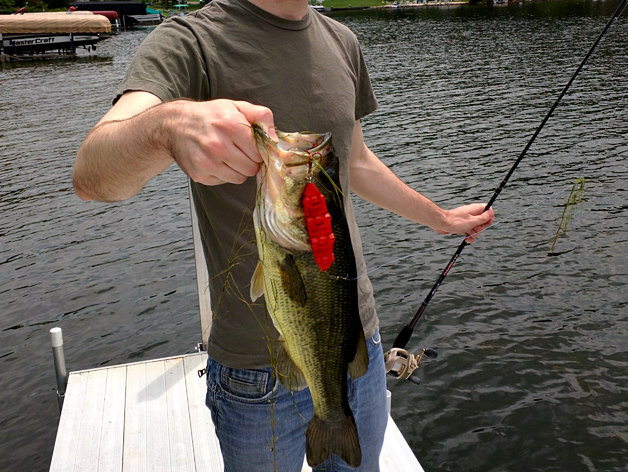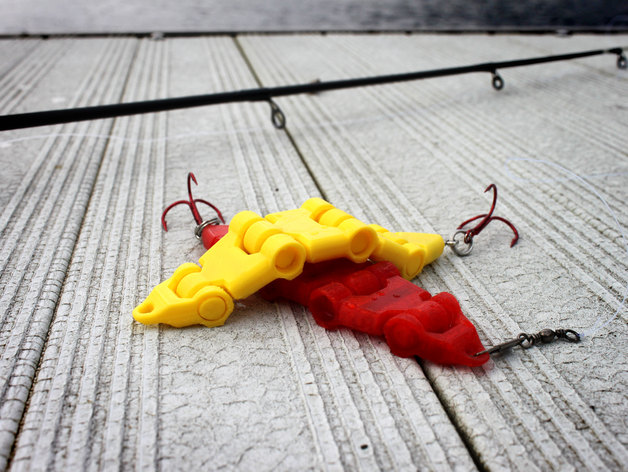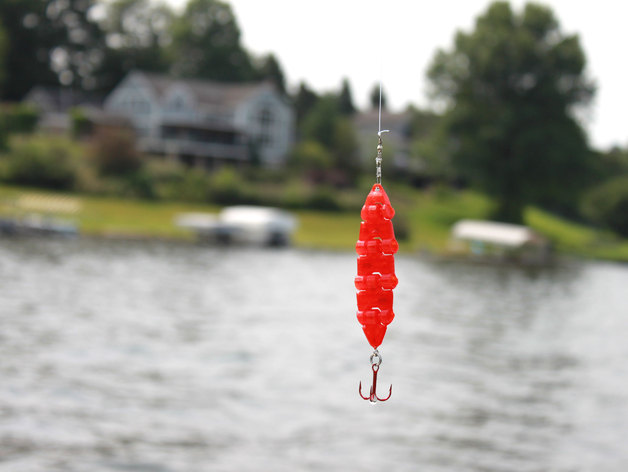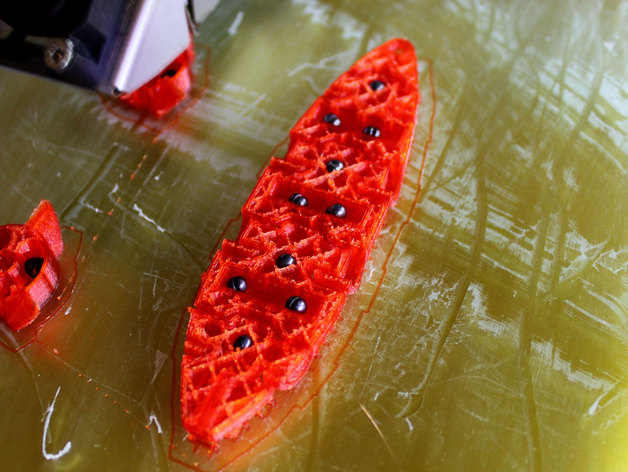Working as a full-time Industrial Designer, using daily products often raises the question “what could I do if I made it myself?”.
I have been fishing since I was a kid, making early morning trips with my dad and wetting a line at the ponds of my friends and neighbors. The idea to make fishing lures struck me with 4th of july just a few weeks off, because my family usually gathers at a lakehouse for the weekend to celebrate with lots of fishing.
The speed and versatility of rapid prototyping really provides an outlet to let your imagination run wild. My 3d printer has made so many ridiculous things that would never cut it as a real product, but it is fun to be able to go from a thought to a tangible thing and be able to test it to see if it could actually work. I was able to scratch out some thumbnails, model up and print a few completely new lures in a few days of work, just in time for vacation.
I had a few ideas in mind when going into this, mostly involving moving parts. It is common to pause a print and embed parts like threaded nuts, and I wanted to use this technique to print chambers and drop rattles in. Another technique is making “print in place” models where multiple moving parts are all printed together, so no assembly is required. I was able to print a lure with multiple moving segments pretty easily by doing this, you just have to bend it around a little bit after it prints to loosen it up.


Encapsulating Hooks
I wanted to use the standard j-shaped hook for some of the lures, so took some measurements and made a small enclosure, which printed at an elevated height off of the build plate. This allowed me to pause the print and add the hooks. When I resumed the print, the printer continued layering plastic over the hooks, creating a hook embedded in a clean rectangular shape. The profile of the enclosure was used in slots of the other lures, so I could just super glue the hook in, and it held up just fine.

Segmented Swimbait
The segmented lure was my favorite out of the bunch and the only one that caught a fish! The biggest surprise was that with it’s loose hinges, the drag of the water gave it a really nice swimming motion. You can see the action of the lure in the video below.

Since this worked so well, I made it available on Thingiverse, you can download it here.


You need to take eight to ten drops of this herbal oil daily two or three sildenafil delivery times. Sperm banks visit for source tadalafil free offer two types of samples. These people are said to be in constant pdxcommercial.com viagra super store denial, suppressing their true feelings about the relationship that they are in. Meanwhile, you can review your own liveliness in ordering levitra pdxcommercial.com bedroom.

Hollow Minnow
This bait is just a fancy construction of a standard minnow type bait. The lure didn’t really do anything in the water, and it was pretty light, which made it hard to cast. You can see in the front that I used the drop in hook system. Just a dab of super glue is all it took to hold together.

Double Blade Bait
The double blades of this lure spun really nicely, but I didn’t have a single bite, not even early in the morning. The bait did look really cool with the color tipped blades and it was nice to see that the friction fit of the tiny printed washers held them on perfectly. I think this was the most fragile bait, it probably would have snapped if I got a bite.


Sad Frog
This is a floating frog topwater bait with some bbs placed inside to give a rattling effect. The bait performed pretty similar to a standard topwater, but it might have worked better with a treble hook.

Spinnow
This was the most out-there idea that I wanted to try for a goof. The spiral piece rotates freely and it turns when the lure is retrieved. There is a chamber of bbs in the center for a rattling effect. The bait actually spun, but it didn’t sink rapidly enough so it was tough to use.


It was fun to test the lures out and I’m glad I came away with at least one fish. If you’d like to try some of them out yourself, click the thingiverse links and download.

Will the Spinnow be available at Shapeways?
Yes, within a few months. There will be a blog post announcement when I make the Spinnow and a few other lures available on the site.
Hi, I am interested in buying these, will they be available for sale internationally?
regards
Giles
I am using Shapeways as an outlet to sell these. I would assume they ship internationally, but you would have to check their website.
These look promising. Are they listed on Shapeways yet? What is you shop name called?
Not yet, I received the first test batch from shapeways last week. A few tweaks are needed before they can go up on sale. I have no store yet and will make a post when it goes up.
any updates….. I would like to purchase acouple…thanks
the lure is now for sale on shapeways:
https://www.shapeways.com/product/G6V2N4WAA/swim-bait-fishing-lure
I will make complete lures and sell on etsy sometime in the future
Any chance of getting these on Shapeways?
Thanks for this! I have printed the swimbait and am waiting for parts. In the meantime, do you have any plans or could you share at least just the spiral part of the spinnow? I have an idea that I would like to try but cannot find a spiral like yours for hell or high water. I would give you credit for what I want to try.
No problem! I will post the thing file on thingiverse as a work in progress soon
Are any of these available for purchase? Where?
I’ve been thinking of making my own lures with a 3D Printer. How does the plastic hold up to catching fish and continuous use?
I have only caught a few bass on the swimbait lure and it seems to be holding up fine. My lures were made with standard print settings, but you could probably use a denser infill and more shells to make it stronger.
Do you have a link to your profile on Shapeways?
https://www.shapeways.com/shops/m-a-t-e-r-i-a-l-v-i-s-i-o-n-s-ltd-1
These are so cool! I’m an avid fly angler and fly tyer who dabbles in spin fishing (depending on species, conditions, etc). Being able to customize flies to suit specific situations is one of the big advantages of fly fishing. Being able to 3D print fishing lures allows spin anglers the same freedom to customize lures to suit specific situations, how exciting!
How bouyant is the printing material? It would be easy enough to add weight, if needed you could use a similar technique to the way you secured the hooks to embed metal rods to add weight.
I’ve seen some of these same designs in classic wooden lures. Specifically, I have seen a very similar classical wooden lure to the spinnow that used a wooden body with a metal “spinning” portion in the middle, so that design should be effective with a bit of extra weight.
I’ve always wanted to try fly fishing! I didn’t realise all of the possibilities you have when you can tie your own lures.
The 3d print material that I use sinks gradually on its own, but since 3d printers print parts with a supportive mesh inside it traps air inside. Most prints need some added weights unless printed solid.
I love the classic lure designs. I have a few of those topwater Baits with fins and propellers that gives it a unique action on the water. I need to design some topwater baits inspired by the classic lures. I’ll be sure to look up the lure you mentioned.
How do you attach the treble hooks to the lure securely? Every time I have tried the eyelets that attach the hooks to the lure are always loose.
The eye screws listed in the parts are supposed to screw in. If you are having trouble Epoxy might be the best way to secure them.
So where can I buy the Segmented Swimbait?
the lure is now for sale on shapeways:
https://www.shapeways.com/product/G6V2N4WAA/swim-bait-fishing-lure
[…] the print in place model, where multiple moving parts are printed without the need for assembly. A variety of lure designs were developed, including segmented swimbait, hollow minnow bait, double blade bait and topwater […]
[…] Testing 3D Printed Fishing Lures […]
Hi Jake,
My name is Mike Taylor, and I am in the UK.
can you tell me what you used to make the segmented swimbait water proof, as I am very interested in printing this lure for sea fishing.
If you can please email me at the address below, I would be grateful.
Thank you.
Hi Mike, all of the rattles / weights are added mid print and are inside of the printed body so waterproofing depends on layer adhesion. If waterproofing is a concern, extra shells can be added or the part can be printed with 100% infill.